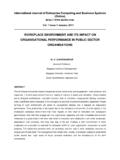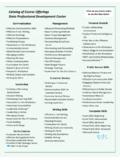Transcription of 04. Flexibility - Parlour
1 PUBLICATION PARTNERPARLOUR GUIDES TO EQUITABLE work practices are becoming increasingly common in architecture. Some architects already enjoy the benefits of flexible schedules or working from home. In architecture the challenge is less to encourage the adoption of flexible work patterns, and more to overcome their often-unspoken career costs. For example, returning to part-time work after parental leave is often considered a career killer, and this inevitably impacts disproportionately on women. This guide looks at some of the benefits of working flexibly in architecture and identifies strategies to help these arrangements run smoothly. >04. Flexibility :guidelines: 4. Flexibility2 What is Flexibility at work? workplace Flexibility is about when people work, where they work, and how they work.
2 Flexibility is a variation from a standard full time, in-office work pattern. Ideally, it should meet the wishes and needs of both employees and employers. The question of when people work is a central part of the idea of workplace Flexibility and includes part-time and casual hours, flexible starting and finishing times, flexible hours worked per week, rostered days off, and unpaid leave. It may include compressed work weeks, annualised hours, part-year employment, taking leave in part days, and the purchase of additional leave. New technologies have increased the options for where people work: at home, on the move or remotely on site. Flexibility in how people work includes job-sharing, hot desking or hotelling as well as technology-enabled options such as video-conferencing, online discussion and other forms of online collaboration, which transform teamwork and information sharing.
3 The flexible career, rather than a linear model, is expected to be more common in architecture, a trend that would be a positive step for women. : See Parlour guide: Career works both ways enabling employees to balance work with external interests and demands, and allowing a practice to respond quickly when projects and workloads change. Employees who are able to access Flexibility are often more willing to respond when the practice has its own Flexibility requirements to meet business or client needs. Staff who feel valued A culture of workplace Flexibility values people and creates an environment in which they feel motivated to do their best work. Recognising and valuing the contribution of their out-of-office lives is also important. Financial benefits of staff retention Research shows that flexible employees are less likely to consider leaving.
4 Staff turnover can be a real headache and the cost of replacing staff is estimated at around one-and-a-half times the annual salary of the position (considering recruitment and training costs, the opportunity costs of being understaffed, and the time-lag on projects). This cost should be weighed against the costs of a flexible arrangement (six months part-time parental or carer leave, for example). Increased productivity Many flexible workplaces (and employees) report vastly decreased stress and increased productivity. There are also important mental health benefits derived from stress reduction, including lowered risk of depression. Business benefits Working flexibly might allow an employee to avoid a long commute at peak hour, work uninterrupted on a complex task, better manage a particularly busy period, or be more available to colleagues or clients after hours or in a different timezone.
5 This brings clear business benefits. guidelines: 4. Flexibility3 Adaptability Practices with engaged, committed employees are better positioned to adapt to an unpredictable and challenging business environment. ChallengesFlexibility does come with some challenges as well as benefits. These need to be understood in order to be effectively navigated. This guide will practices, employees manage the challenges and thereby realise the opportunities. workplace resistance There can be workplace resistance to implementing a Flexibility -friendly culture. Employees may be anxious that part-time work is a career-limiting move or that flexible work practices will be imposed. Employers may be concerned that Flexibility will generate extra administration, reduce access to an employee or raise trust and servicing clients Flexible work patterns are perhaps most complex for architects in intensive day to day client-contact roles.
6 How these issues are handled can vary according to the needs of the client (who may also desire Flexibility ) and the employee (who may be available for client contact, even when they are not formally at work). Flexibility does require more organisation and some balance or work/life blur The blurring of work boundaries thanks to new technologies generates different opinions. Some are wary of a merging of work and life, while others find the work/life blur gives them increased Flexibility in both realms. Both of these responses are legitimate. Either way, the capacity to negotiate flexible working patterns is important, with a mutual understanding of availability, response times and communication at work and elsewhere. Why does it matter?In architecture, as in many professions, there is a clear gendered pattern whereby women are much more likely than men to work part time or use flexible conditions.
7 Career impacts Coupled with the fact that flexible work practices are often seen as a career deadend, this pattern has far-reaching adverse effects on women in architecture. It contributes to their under-representation in leadership roles, to gender-based pay inequity and, in some cases, a two-tier system where part-time and flexible workers are seen as less legitimate or committed workers. This is a systemic problem and calls for a cultural change in men While flexible work is often considered an acceptable necessity for women, it s much less so for men. Flexibility for men is often perceived as a poor career move. If flexible working conditions are to become mainstream and accepted as a legitimate career choice in architecture, they will need to be taken up by a large proportion of the profession, including by senior men.
8 One challenge for architecture practices pursuing a more equitable culture is to ask: how can we shift the culture to make it acceptable for men to work flexible hours? Cultural shifts If working flexibly was the norm, it would likely have a significant positive impact on gender equity in architecture. We need a new culture that not only supports women and men in their attempts to balance family life and architectural work, but also encourages work habits that flexibly meet the needs of both practices and : 4. Flexibility4 What can we do?Where Flexibility is embedded rather than bolted on, it has the potential to revolutionise the possibilities of an architectural career and of architectural practice. Everyone has a role to play in achieving a successful flexible work environment.
9 Individuals can set out the business case for a flexible role, and be prepared to offer Flexibility in return. Work colleagues can be open and supportive of Flexibility at work, focusing on outcomes and achievements rather than time in the office. Practices can recognise the benefits of Flexibility for all, and offer a broad range of flexible working opportunities to employees, both men and women. Flexible working often requires greater organisation and communication than more traditional styles of work, but the benefits for practices and individual employees can be substantial. PracticesArchitecture is a tough, demanding industry. It s difficult to remain stable and profitable, and this puts pressures on all aspects of the business. One of the easier benefits to offer staff is higher Flexibility , and this can have wide-ranging positive impacts across the business.
10 Developing and embracing effective flexible working arrangements simply makes good business open to new ideas and new ways of workingFlexibility involves a creative rethinking of the conditions and processes of work in order to better suit the people and practice involved. Flexible work arrangements are inherently responsive: they react to specific needs at a particular time. Rethink time, location and mode of work. There are endless possible permutations at the disposal of a creative employee and supportive director or supervisor. Remember that flexible arrangements do not necessarily reduce a full-time load: the hours may be filled at irregular or discontinuous times. Be flexible about flexible conditions. It will enable you to revisit the arrangement to ensure it s working effectively for all.






